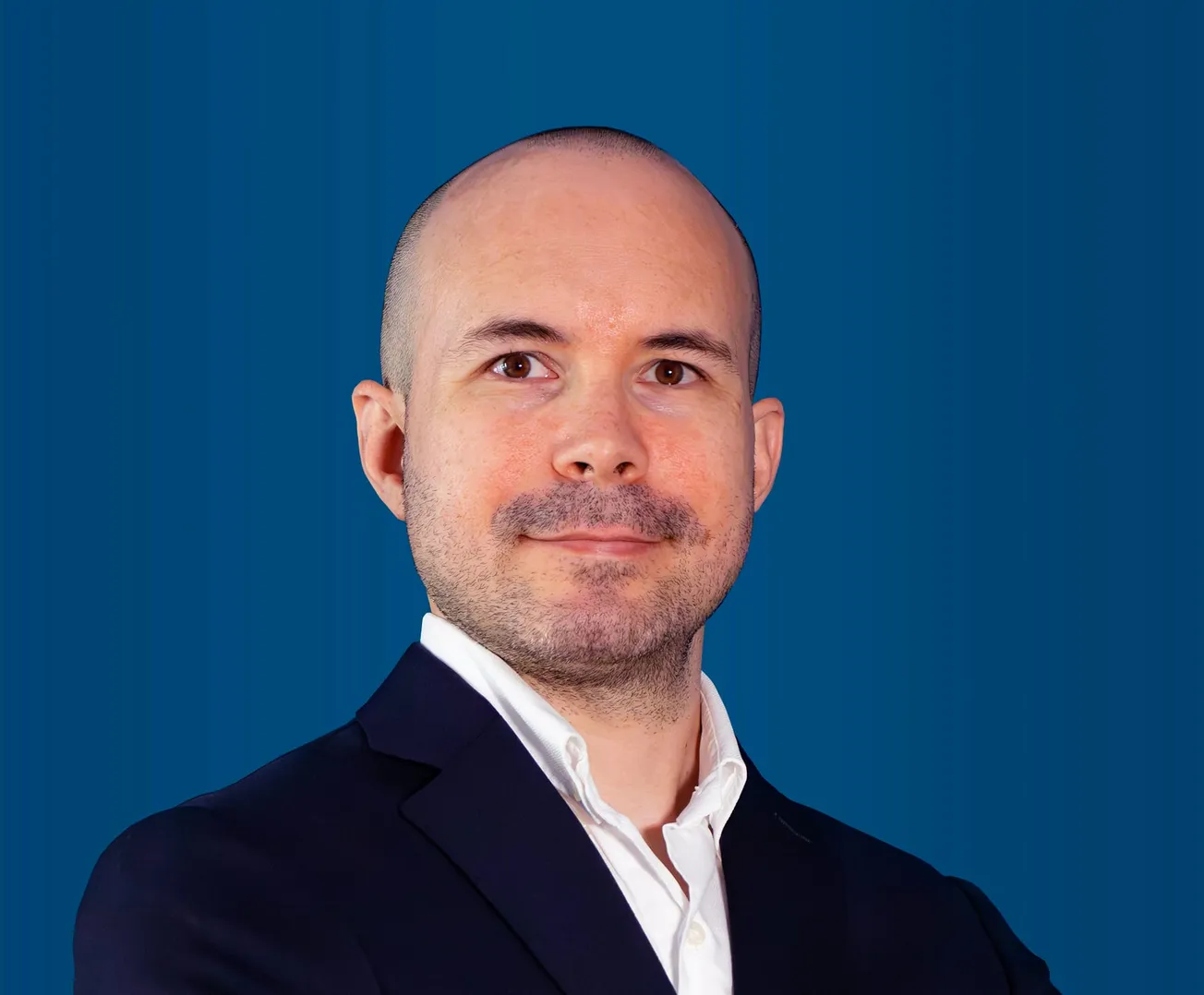Table of Contents
Can you put your finger on what’s inspired you throughout your career?
I started out as a hospital pharmacist and did that for about a decade. Making rounds in hospitals, interacting with patients—that experience still inspires me today.
My background in hospital pharmacy still anchors me. My wife is a nurse, so between us, we truly understand the difference medicines can make in people's lives. But I knew I wanted to do more, so I went to business school - I've now spent 25 years in biopharma, dealing with large and small molecules, and gene therapy.
My first day in biopharma was at a small company called Centocor Biologics. Coincidentally, it was a company meeting day. I was one person among more than a hundred in the audience, and on stage was a woman in a wheelchair. She was a mother in her fifties with rheumatoid arthritis.
And she got out of her wheelchair and she walked. She said, "This is because of the medicine you've been working on—Remicade." I was hooked. Witnessing something like that is incredible.
A few companies later, I was at InterMune, a small molecule company. We got a medication called Esbriet approved for idiopathic pulmonary fibrosis (IPF). Incidentally, my wife, being a nurse at a cardiopulmonary center, saw patients with IPF. The disease affects men more than women, so it was often the wives who would hug her and say, "Tell your husband ‘thank you’ for bringing this medication for my husband; he's doing much better now."
Before Affinia, I was at AveXis, a gene therapy company. There, we brought to patients a medication called Zolgensma for spinal muscular atrophy (SMA). This disease affects babies, especially SMA Type 1. These babies are missing or have a defective SMA gene and typically don't live past the age of two. The disease is also called "floppy baby syndrome," which gives you an idea of how heartbreaking it is.
With Zolgensma, a one-time dose delivers the gene, starts making the protein, and it transforms the lives of these kids - they're talking about careers, becoming ballerinas or pilots. I still have a picture of the first 12 kids who participated in the trial. This is what our industry is about. At Affinia, the vision is to make those kinds of medicines and make a real difference for humanity.
Can you give us an overview of Affinia's pipeline? What are you working on?
Gene therapy holds incredible promise, but the challenge has always been delivery. In some diseases, gene therapy has made a difference using conventional serotypes—natural capsids. But these only work in certain diseases. If we want to make a broader impact across many other diseases, we need to solve the delivery problem.
At Affinia, we do something pretty cool. We take natural adeno-associated viruses (AAVs) and rationally design tissue-targeting peptides—essentially honing devices—that we place on the surface of the AAV capsid. These peptides guide the capsid to specific tissues of interest. We have capsids that deliver genetic cargo to the heart and others that target the brain, much more effectively than conventional capsids. I'm not talking about a 10% or 20% improvement. We're seeing orders of magnitude better delivery in terms of the amount of protein or RNA they can express.
Our first program focuses on inherited heart disease. Clinicians are increasingly testing patients for specific gene mutations behind these diseases. One example is a mutation in the BAG3 gene. BAG3 is a crucial protein in heart cells; it maintains the structure and is responsible for the electrical signaling that makes the heart beat. Patients with this mutation don't produce the protein, so their hearts don't function properly.
The heart doesn't pump enough, it expands, and patients experience constant shortness of breath. Many require a heart transplant at a young age—some are diagnosed before they're 20, with the average around 37.
Our investigational gene therapy uses our engineered capsid to deliver the BAG3 gene directly to heart cells. It's meant to be a one-time dose, infused into the patient. We've seen in preclinical experiments that it starts making the protein and restores heart function.
The hope is that when we move into clinical trials, we'll be able to improve not just heart function but also the patients' quality of life and health span. That's just one example of how we're realizing our vision.
When you speak about a rationally designed therapy, what does that mean?
It's always catchy to use three-letter acronyms, right? So, we call it ART, which stands for Affinia Rationally-designed Therapeutics, but it also plays on the idea that science can be an art. What we mean by "rationally designed" is that we methodically engineer the peptides that go on the surface of the AAV capsid.
We take the natural AAV and design tissue-targeting peptides by looking at the amino acid sequences. We analyze how changing a single amino acid affects the characteristics of the peptide-capsid combination. We're essentially creating a structure-activity relationship, which is a concept that's been very successful in small molecule drug development but hasn't been applied to AAVs before.
To manage the vast number of possible peptide variations—more permutations than there are stars in the universe—we use analytical tools like artificial intelligence, including machine learning. This allows us to predict which peptide sequences will give us the desired tissue targeting and delivery efficiency.
We also use barcoding techniques to track where each engineered capsid goes in our experiments. This rational design approach significantly shortens our development cycles and increases our probability of success compared to more random methods. Patients don't have time to wait, so our method is both efficient and patient centric.
What's your progress with the FDA?
While I can't go into too much detail, I can say that we're in a very good place with our regulatory discussions. This positions us well to advance our first product candidate into clinical trials in the near term.
What is your relationship with Vertex Pharmaceuticals?
For a company like ours, with a platform that's widely applicable across various tissues and diseases, partnerships can be incredibly valuable. While we're focusing on the heart and brain, our technology could also be applied to the kidney, eye, lung—you name it.
We entered into a partnership with Vertex because they share our scientific rigor, and they're relatively local, which made collaboration easier. They were interested in two specific indications: Duchenne muscular dystrophy and myotonic dystrophy, both of which primarily affect skeletal muscle but can impact other tissues as well.
Vertex provided us with predefined criteria for the capsids they needed. Using our rational design method, we engineered capsids that met their specifications. It's been a fantastic collaboration—a true win-win. They benefit from our technology, we learn from their expertise, and ultimately, patients stand to gain from the medicines that will come from this partnership.
What are the main goals and milestones for Affinia in 2025?
Like many platform companies, we're now moving from the thesis and platform development phase to the product development phase. We've successfully created these new capsids with targeted delivery capabilities. For 2025 and beyond, our vision and ambition are to progress our product candidates toward clinical trials.
We've developed the genetic payloads, identified the patient communities, and are advancing our candidates through the necessary preclinical experiments. Our immediate focus is on genetic heart diseases, but we're also working on programs targeting brain diseases and other areas. The goal is to bring these therapies into the clinic and, ultimately, to the patients who need them.
Looking ahead to the industry as a whole, what trends have you noticed that could be crucial going forward?
There are several exciting technological advances that we've benefited from. Next-generation sequencing, for example, has been instrumental in our ability to analyze and track our engineered capsids. We didn't invent these technologies, but we've applied them innovatively to our work.
Artificial intelligence and machine learning have enabled us to handle the complex data and vast permutations involved in our rational design process. Additionally, the identification of new genes underlying various diseases allows us to develop therapies for new subpopulations of patients.
On the clinical side, physicians are diagnosing patients earlier and subtyping them based on specific genetic mutations. This precision medicine approach means that therapies like ours can be more effectively matched to the patients who will benefit the most.
As for challenges, I don't think any CEO in biotech would avoid mentioning the current macroeconomic environment. The last few years have been different, especially compared to the initial period during the pandemic when there was a surge in fundraising and investment in biotech. Things have normalized since then, which I believe is healthy. It encourages companies to focus on solid science, robust data, and clear paths to patient impact.
What do you feel are the most important principles for successfully running a company with so many moving parts?
It all starts with people. We can talk about technology, science, and market conditions, but many of those factors are beyond our control. What makes a company successful is the team behind it. Bringing in the right people—those with prior experience or the ability to learn and adapt—is crucial. Biotech is a challenging industry; the odds are long for success. But when you have a team that's determined, innovative, and passionate, you can overcome challenges.
Surrounding yourself with people who are smarter than you and who share a common purpose is key. At Affinia, I'm humbled and privileged to work with such a team. We keep our purpose front and center: why we exist as a company and the impact we aim to have on patients' lives. In our monthly company meetings, we remind ourselves that the work we're doing is meant to benefit someone out there—a friend, a colleague, a stranger, a parent, a child. It helps everything fall into place.





